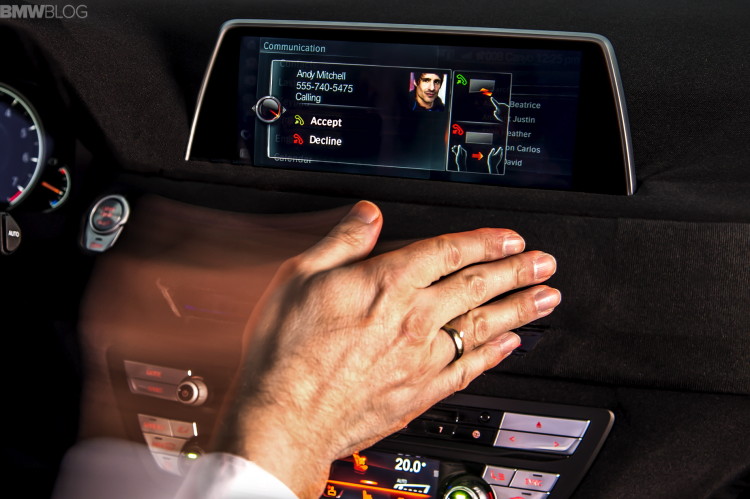Gesture Control never arrived quietly. BMW introduced it in 2015 on the then-new G11 7 Series, framing it as the next step in keeping a driver’s eyes on the road and hands free of extra motions. On paper, that logic made sense: instead of reaching for a button or searching for a dial, you’d make a simple hand movement in mid-air and the car would respond. It sounded neat. It even felt futuristic the first few times you tried it. And kids loved it.
But once the novelty faded, something else became obvious: most drivers stopped using it. And after nearly ten years, BMW’s internal studies ended up confirming the same thing, which is why Gesture Control quietly disappears with the arrival of iDrive X.
The idea didn’t fail because drivers don’t like technology. BMW owners welcome tech — often more eagerly than buyers of any other premium brand. Gesture Control failed because the system never became easier, faster, or more natural than the controls already in place. And in a moving car, “natural” wins every time.
Step 1: Understand what Gesture Control actually let you do
The system launched with a small set of specific motions, and although BMW expanded them slightly over the years, the vocabulary never grew beyond a narrow set of tasks.
There was the familiar circular volume gesture: finger extended, drawing a slow loop in the air until the system picked it up. Clockwise raised volume; counterclockwise lowered it. One full rotation was usually required, and the system worked best when you used your whole hand, not just a floating fingertip.
You could accept a call by pointing at the screen, then retracting your hand. You could reject a call — or dismiss pop-ups — with a sideways swipe. These same motions could also cancel voice commands.
There were two skip gestures — thumb outstretched to the left or right to skip tracks or cycle stations. Useful on paper, but easy to trigger accidentally if you talk with your hands.
The pinch-and-drag motion, done with your thumb and index finger, let you rotate the Surround View camera from side to side. It looked great in a demo but only worked when parked, which made it feel like more of a showroom trick than a core tool.
And then came the configurable gestures.
This was the one part of the feature that hinted at its promise. You could use a quick “open-closed-open” hand motion or a two-finger point to trigger something you programmed — muting the audio, toggling the display, or even starting navigation to your home address. These custom gestures had real potential, and for the tiny percentage of people who took time to set them up, they were genuinely handy.
But the system always demanded a bit of choreography and a bit of patience. And that’s where the friction began.
Step 2: Look at the interaction itself — it wasn’t effortless
Gesture Control wanted your hand inside a specific invisible box in mid-air. BMW themselves explained it well years ago: imagine two perpendicular lines, one rising from the shifter (or lower dash in cars without a conventional shifter) and another from the top of the air vents. That intersection — the space between those lines — was your “gesture zone.” Too high or too low and nothing happened. Too quick and nothing happened. Too subtle and nothing happened.
Even when you nailed the placement, the sensor needed a clear reading of your whole hand. Gloves, jewelry, vaping, a charm hanging from the mirror — none of these played nicely with the overhead camera. Sometimes the system felt confident. Sometimes it felt like it didn’t see you at all.
When a user interface introduces question marks where a knob or button never does, people start abandoning it.
Step 3: Compare it to the controls it was supposed to replace
This is where Gesture Control struggled the most. Rotating your finger in a circle to change the volume might sound slick and cool, but in motion, it’s slower and more awkward than brushing your thumb over the steering wheel roller. That roller is small, tactile, and instantly reliable. It gives feedback. It never guesses.
Pointing at the screen to answer a call also lost the fight. The steering wheel button sits right under your thumb. You don’t need to find anything; your thumb has been pressing that same button for years.
Even the more “fun” gestures — the skip motions, the custom hand-open-hand-close sequences — were up against simple taps and swipes that people already understood.
Gesture Control always had to prove it was better than what came before it, and it never managed to do that.
Step 4: People felt awkward using it
This is the part that doesn’t show up in technical evaluations but mattered the most. Waving your hand in the air in a specific, almost theatrical way — especially when someone else is in the car — can feel faintly ridiculous.
Plenty of drivers are expressive with their hands when talking, but those motions are instinctive. Gesture Control wasn’t. You had to perform for the camera. And when something asks you to perform, you become self-conscious.
That alone kept a lot of people from revisiting the feature after the initial novelty wore off.
Step 5: The system never grew beyond its debut
Over time, BMW refined the hardware and software, sharpened the camera logic, and expanded iDrive in every direction. But Gesture Control almost froze in place. It never stretched into climate adjustments. It never handled navigation input. It never moved into deeper infotainment controls. It always remained a small pierce of the overall interface.
Meanwhile, BMW’s voice assistant grew into something far more capable. Steering wheel controls stayed consistent, at least most of it. Touchscreen usage has increased as well. And iDrive X, arriving with the next iX3, pushes even harder toward a voice-first, screen-centric cabin with several displays and interactions in the car. That design direction leaves less room — and less need — for hand gestures floating in mid-air.
No surprise, then, that Gesture Control is gone in iDrive X. Even BMW admitted owners weren’t using it.












































































